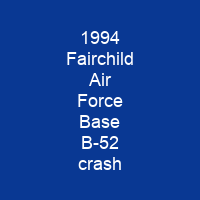The Tragic Crash at Fairchild Air Force Base: A Lesson in Crew Resource Management
Imagine a day that changed the course of aviation history, forever etching itself into the annals of military and civilian safety protocols. On June 24, 1994, a US Air Force Boeing B-52 Stratofortress crashed at Fairchild Air Force Base, killing Lieutenant Colonel Arthur ‘Bud’ Holland and three other crew members. This event was not just a tragic accident but a stark reminder of the importance of adherence to safety regulations and the critical role of leadership in ensuring such protocols are followed.
The Crew and Mission
Let’s delve into the details of that fateful day. The B-52H bomber crew consisted of pilots Lieutenant Colonel Arthur ‘Bud’ Holland, Lt Col Mark McGeehan, Colonel Robert Wolff, and weapon systems officer/radar navigator Lt Col Ken Huston. Their mission was to execute a demanding series of low-altitude passes, 60° banked turns, a steep climb, and a touch-and-go landing. The aircraft took off at 13:58 and completed most of the mission without incident.
The Crash Sequence
However, upon executing a 360° left turn around the tower, Holland flew the aircraft in an extremely tight, steeply banked turn while maintaining low altitude. The aircraft then banked past 90°, descended rapidly, clipped power lines and hit the ground, exploding and killing the crew. This sequence of events was captured on video and shown worldwide, serving as a somber reminder of the consequences of disregarding safety protocols.
The Investigation
Following the crash, an investigation was launched to determine the root causes. The AFR 110-14 investigation identified several factors contributing to the crash, including Holland’s personality and behavior, previous supervision and lack of corrective action, mission planning and execution, and other environmental and human factors.
Holland’s Personality
The investigation concluded that the crash was primarily due to Holland’s personality and behavior. USAF personnel testified that he had developed a reputation as an aggressive pilot who often broke flight-safety and other rules. His actions were not isolated incidents; they spanned over several years, including multiple violations during air shows and training missions.
Leadership Failures
The investigation also highlighted the failures of USAF leaders in addressing Holland’s repeated rule-breaking behavior. Colonel Arne Weinman and Colonel Arnold Julich verbally reprimanded Holland but took no formal action. Similarly, Colonel Capotosti warned Holland that violating safety regulations would result in being grounded if he did it again. Despite these warnings, Holland continued to break rules.
The Aftermath
The crash sequence found that the B-52 entered its final turn sequence around the tower with an indicated airspeed of 182 knots. The aircraft’s airspeed decreased, and despite input from Holland, it continued to drop. Eight seconds before impact, the aircraft entered a turning flight stall due to the bank angle increasing past 60°.
The accident board stated that Holland regularly and illegally broke safety regulations, including flying below minimum-clearance altitudes, exceeding bank-angle limitations, and executing a wingover during a change-of-command ceremony. After witnessing a flyover, Colonel Arne Weinman and Colonel Arnold Julich verbally reprimanded Holland but took no formal action.
Training Tool
The Fairchild crash is now used as a training tool in military and civilian aviation environments to teach the importance of crew resource management. The incident serves as a stark reminder that even the most experienced pilots can make critical errors if safety protocols are not strictly followed. The B-52, once a symbol of military might, now stands as a testament to the fragility of human judgment in high-stress situations.

The tragedy at Fairchild Air Force Base serves as a powerful reminder of the importance of safety in aviation. It underscores the need for strict adherence to protocols and the critical role that leadership plays in ensuring these standards are met. As we reflect on this event, let us remember the lives lost and use their memory to strengthen our commitment to safety.
You want to know more about 1994 Fairchild Air Force Base B-52 crash?
This page is based on the article 1994 Fairchild Air Force Base B-52 crash published in Wikipedia (retrieved on November 28, 2024) and was automatically summarized using artificial intelligence.







